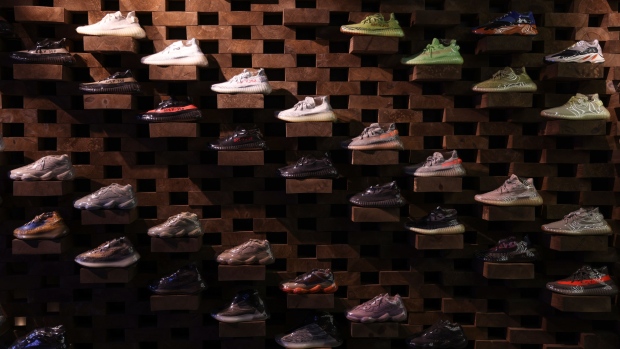Jan 31, 2024
Adidas Plans More Yeezy Sales After €1 Billion Currency Hit
, Bloomberg News

(Bloomberg) -- Adidas AG slumped after the German company said currency swings will worsen the effects of a slowdown in the sports apparel market, restricting earnings to less than half of analysts’ estimates.
Operating profit should be around €500 million ($542 million) in 2024, Adidas said late Wednesday, compared with an average analyst estimate of €1.27 billion.
Adidas suffered a €1 billion currency hit from factors including a devaluation of the Argentine peso in 2023 and said foreign-exchange movements will continue to weigh on its finances this year. The Latin American nation’s currency has plunged since President Javier Milei took office and instituted a shock treatment to try to jolt the stagnant economy.
Adidas shares fell as much as 9% early Thursday in Frankfurt. The stock has lost half its value since a peak in 2021.
Rivals Nike Inc. and Under Armour Inc. also dropped in US trading Wednesday. Investors have been worried about weakness in the sector after Nike raised doubts in December about consumer demand in China and around the world and Puma SE warned about the impact of hyperinflation in Argentina.
Adidas plans to mitigate some of the damage by continuing to sell left-over inventory from its defunct Yeezy partnership with the rapper Ye. The shoemaker said it will sell €250 million of remaining Yeezy products at least at cost, rather than writing it off.
Chief Executive Officer Bjorn Gulden, in a webcast Thursday, called the forecast a “worst-case scenario.”
“Everything we are saying is conservative,” he said.
Gulden has a history of offering cautious outlooks early in the year and repeatedly outperforming them, a hallmark of his decade-long tenure as CEO of crosstown rival Puma. The Norwegian is entering his second year at the helm of Adidas, where he’s inherited a collection of crises from his predecessor.
Despite the profit lag and the current weakness in the sports business, Adidas forecast a return to modest sales growth later this year as it continues its turnaround efforts.
Currency-neutral sales will probably rise by a percentage in the mid single digits in 2024, Adidas said. That’s roughly in line with what analysts were estimating. The company expects sales to start out “flattish” this year and then improve every quarter.
Cautious Outlook
“Some healthy dose of caution is embedded in today’s words,” wrote James Grzinic, an analyst at Jefferies. Gulden said on a call Thursday that there’s a potential upside to the Yeezy sales, indicating that Adidas might make some profit on the collection.
In 2023, Adidas’s currency-neutral revenue stayed flat, which was an improvement upon earlier targets, the company said.
The company could conceivably boost its earnings if it can make more money off of its remaining Yeezy inventory rather than merely recoup costs, as is its current plan. It’s now only written off €12 million of products that was “either damaged or very broken in sizes,” Gulden said. He said Thursday there’s a potential to a better performance for Yeezy sales, and Adidas is planning a third bulk sale of the product.
Adidas is not the only company to see revenues impacted by the 54% devaluation of the peso’s official exchange rate in Argentina; Citigroup took an approximately $880 million hit in the fourth quarter.
The scale of these hits raises questions about why Adidas and others were so heavily exposed. Typically, companies hedge their exposure to more volatile currencies to prevent abrupt moves from derailing their profits. Indeed, global currency volatility was lower last year than in 2022, according to a JPMorgan Chase & Co. index.
--With assistance from James Cone and Rachel Evans.
(Updates with currency effects in third and final two paragraphs)
©2024 Bloomberg L.P.






